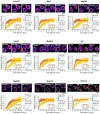A quantitative map of nuclear pore assembly reveals two distinct mechanisms
- PMID: 36599981
- PMCID: PMC9849139
- DOI: 10.1038/s41586-022-05528-w
A quantitative map of nuclear pore assembly reveals two distinct mechanisms
Abstract
Understanding how the nuclear pore complex (NPC) is assembled is of fundamental importance to grasp the mechanisms behind its essential function and understand its role during the evolution of eukaryotes1-4. There are at least two NPC assembly pathways-one during the exit from mitosis and one during nuclear growth in interphase-but we currently lack a quantitative map of these events. Here we use fluorescence correlation spectroscopy calibrated live imaging of endogenously fluorescently tagged nucleoporins to map the changes in the composition and stoichiometry of seven major modules of the human NPC during its assembly in single dividing cells. This systematic quantitative map reveals that the two assembly pathways have distinct molecular mechanisms, in which the order of addition of two large structural components, the central ring complex and nuclear filaments are inverted. The dynamic stoichiometry data was integrated to create a spatiotemporal model of the NPC assembly pathway and predict the structures of postmitotic NPC assembly intermediates.
© 2023. The Author(s).
Conflict of interest statement
The authors declare no competing interests.
Figures















References
-
- Hampoelz, B., Andres-Pons, A., Kastritis, P. & Beck, M. Structure and assembly of the nuclear pore complex. Annu. Rev. Biophys.48, 515–536 (2019). - PubMed
Publication types
MeSH terms
Substances
Grants and funding
LinkOut - more resources
Full Text Sources

